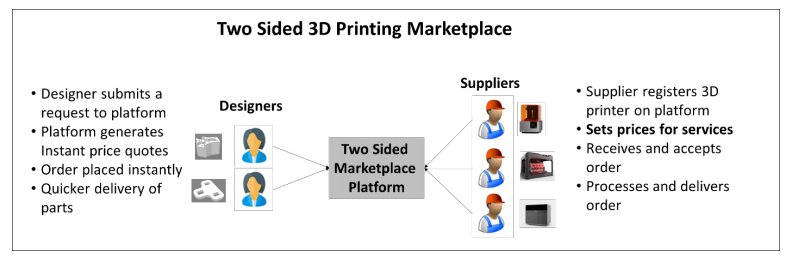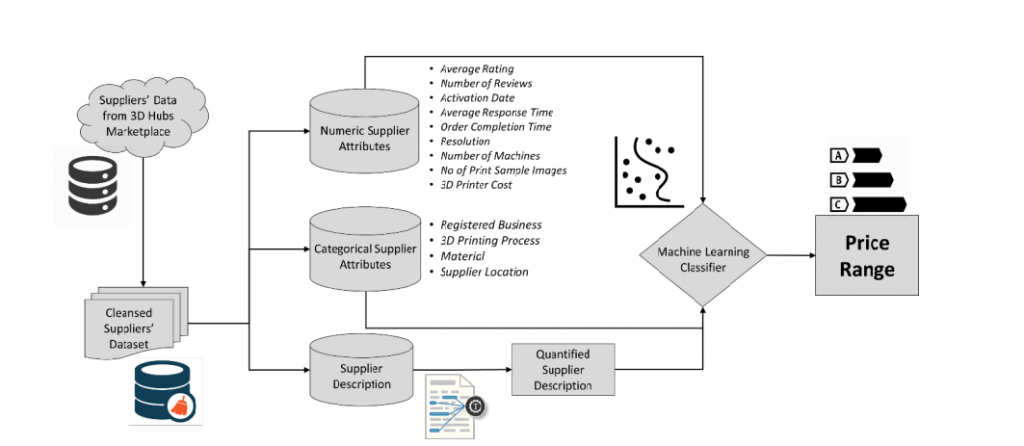3D printing industry news sliced: SLM Solutions, Stratasys, nTopology, Rapid Shape and more
3DEO passes 150,000 part milestone on quest to achieve high volume manufacturing
Sculpteo publishes State of 3D Printing 2020 survey: 3D printing for production increases
How Rapid Prototyping Has Revolutionized Product Development
From demonstrating proof of concept to testing the viability of a new part, prototypes are an essential part of the design process. Advancements in rapid prototyping technology, including processes like CNC machining and SLS rapid prototyping, have completely revolutionized the way that engineers review, test, and display their final designs.
What is rapid prototyping?
Rapid prototyping refers to a variety of computer-aided manufacturing processes that are capable of replicating parts from digital models. These processes are highly accurate and take far less time than traditional manufacturing methods.
Many engineers automatically associate rapid prototyping with additive manufacturing processes like 3D printing. Parts made with additive manufacturing are created by layering plastic, resin, or other materials in the shape of the final product. Some post-processing may be required to remove support structures and achieve the desired finish.

Rapid prototyping can also be accomplished with subtractive manufacturing. Subtractive processes like CNC machining create parts by removing layers from a block of metal, wood, or resin. Sheet metal prototyping can also be used to bend or cut metal into the desired shape based on computer-provided specifications.
In general, additive processes like SLA or SLS rapid prototyping are used to create complicated designs and low-cost visual models. Subtractive processes like CNC rapid prototyping are used for durable end-use parts or detailed models with high manufacturing tolerances.
Why traditional manufacturing isn’t enough
Prototyping is an essential part of the design process, but it hasn’t always been economically viable for most design teams. Creating a prototype with traditional manufacturing methods is often incredibly expensive and takes too long for an efficient design cycle.
The main problem is that most traditional manufacturing processes like injection molding require custom molds, tools, and other starting equipment. These non-recurring costs are negligible for large print runs, but they become prohibitively expensive for single prototypes.
As a result, many engineers were reduced to creating custom prototypes by hand or paying high up-front costs to a manufacturing specialist. Design teams were faced with the choice of either paying for an expensive prototype or sending a design to production without proper testing.
Luckily, rapid prototyping has none of the problems that come with traditional manufacturing. Processes like CNC machining and SLS rapid prototyping have no start-up costs, can be completed in short time frames, and allow engineers to create an exact replica of their original design.
Efficient and affordable production
When the first rapid manufacturing methods were developed, engineers immediately saw the potential for prototyping and design. Thanks to computer-aided technology, even a standard CNC turning service could now be used to create perfect replicas without the costs typically associated with traditional manufacturing.
All rapid prototyping services share the same feature of low start-up costs and a standardized price per unit. Because no custom molds or equipment are required, the per-unit price remains nearly identical for all levels of production. This makes it viable to order one, five, fifty, or a hundred parts on an as-needed basis.
Rapid prototyping lets engineers order scale models of their designs with incredibly short lead times. Depending on the rapid prototyping service, finished parts could be delivered within less than one week. Online manufacturing platforms streamline the process even further by introducing instant quote generation and an accessible online portal where engineers can track and manage existing orders.
With low costs and short lead times, it’s no surprise that many engineers have added rapid prototyping as a standard part of their design process. Design teams can compare visual models, test different materials, and create a perfect version of their product for final manufacturing.
Common applications for rapid prototyping
Services like 3D printing and CNC rapid prototyping are widely used by both individual and corporate design teams. Rapid prototypes are often used throughout the entire design process to help engineers create accurate parts and avoid costly changes during actual production.
- Conceptual models: One of the most popular uses of rapid prototyping is to create proof-of-concept models during the early stages of the design process. These models are used to communicate ideas and demonstrate project viability to interested parties. Thanks to the speed and efficiency of processes like SLS rapid prototyping, engineers can rely on these models to be available early in the design cycle.
- Functional prototypes: The parts made with SLS and CNC rapid prototyping are as durable and functional as parts made with traditional manufacturing. Depending on the process, the part will often look and feel exactly the same as the consumer-ready product. This means that engineers can make changes to the prototype and trust that they will reflect accurately on the final design.
- Pre-production design: Some prototypes show that a design is ready, while others highlight obvious flaws and areas that need additional work. The main benefit of rapid prototyping is that it allows engineers to go through an iterative design process. As soon as a change is made, the design team can order a new prototype and expect to receive it within a viable timeframe.
From 3D printing to sheet metal prototyping, rapid manufacturing can be used to create highly accurate models of nearly any design. Test the possibilities and compare material options by uploading a design to the 3D Hubs manufacturing platform today.
The post How Rapid Prototyping Has Revolutionized Product Development appeared first on 3DPrint.com | The Voice of 3D Printing / Additive Manufacturing.
3D Hubs 3D Printing Trends Report forecasts 24% growth in 3D printing industry over 5 years
80 additive manufacturing experts predict the 3D printing trends to watch in 2020
New jobs in 3D printing from XYZprinting, Kodama and Eaton
3D Printing Service Bureaus: Refining Pricing Systems with More Progressive Cost Analytics
Deepak Pahwa and Binil Starly provide cost analytics for 3D printing services bureaus in their recently published paper, ‘Network Based Pricing for 3D Printing Services in Two-Sided Manufacturing-as-a-Service Marketplace.’ Taking a different approach from ‘ad-hoc and subjective’ pricing, the authors suggest a more formulaic route, in using machine learning methods to arrive at prices for clients.
In their new pricing model, the following would be considered in setting rates:
- Supplier experience
- Supplier capabilities
- Customer reviews and ratings
- Scale of operations
Today, most service bureaus arrive at a price after calculating their obvious costs, like what materials are to be used in making a prototype or part, and the amount of energy and labor to be expended in the process. Obviously, profit needs to be figured in too for most companies. Some may factor in higher annual overhead costs, higher costs for the machinery they have invested in, along with issues like pre- and post-processing.
Sharing economical vision with other progressive companies like Airbnb, the authors suggest the idea of a ‘data mining tool’ that tabulates a list of details to better predict price ranges, bring in clients, and make the potential of sales more likely. These are obvious recipes for success, judging by the popularity of such companies who also filter the work and much of the profit to private individuals, or in the case of 3D printing, users.
“Sharing Economy platforms in additive manufacturing industry can benefit by adopting data driven approaches to support suppliers with price prediction,” state the authors.
The authors went to one of the best industry sources, ‘scraping data’ from public profiles of service bureaus at 3D Hubs—an enormous an continually growing organization that helps 3D printing bureaus of all sizes around the world thrive. The researchers found 29,544 suppliers listed, but after ‘cleaning’ their data, a more concise 546 suppliers with 5,469 service listings located in the United States and 1,043 suppliers with 9,808 service listings in Europe.
“Every supplier has a supplier profile which provides information about its service listings and its reputation on the marketplace. A service listing is a unique combination of a 3D printer, material, resolution and a corresponding price,” stated the researchers.
While 346 unique types were listed in detail, they were categorized by:
- Acrylonitrile Butadiene Styrene (ABS)
- Polylactic Acid (PLA)
- Specialty ABS
- Specialty PLA
- Polyethylene Terephthalate (PET)
- Specialty PET
- Polycarbonate (PC)
- Specialty PC
- Nylon, Specialty Nylon
- Flexible Material (Thermoplastic Elastomer/ Polyurethane)
- Acrylonitrile Styrene Acrylate (ASA)
- Metals
- Resins
- Soluble Material (High Impact Polystyrene, Polyvinyl Alcohol)
- Others
Parameters for 3D printers included how much it cost to purchase the 3D printer, and what type of process was involved in making the product, with the following categories:
- Fused Deposition Modelling (FDM)
- Stereolithography (SLA)
- Laser Sintering (Selective Laser Sintering for polymers and Direct Metal Laser Sintering for Metals)
- Jetting (Material and Binder Jetting)
The authors used GPS coordinates for suppliers, using a clustering algorithm to study their data, with 528 different 3D printers identified, and 100 suppliers selected randomly for the research. Details such as key words, reviews from customers, and their actual abilities to provide services were plugged in to analyze price ranges for suppliers.
“These marketplaces generate large amount of data which can be used to understand the participants and provide additional value to them. Historical sales data from a manufacturing marketplace could be used to determine the probability of winning an order at a specific price. In addition to supplier’s features, order attributes such as 3D design, its due date and designer’s attributes such as future potential of orders from the designer can also be considered for price prediction,” concluded the researchers.
“Impact of additional parameters such as demand forecast, seasonal variation and raw material prices can be added to the model to make it more robust.”
The ability to go to a service bureau is an effective way for users to put their concepts into reality without having to put capital into software, hardware, and materials whether they are using them for electronics, working to connect with other professionals too, or working with more industrial materials like metal. What do you think of this news? Let us know your thoughts! Join the discussion of this and other 3D printing topics at 3DPrintBoard.com.
[Source / Images: ‘Network Based Pricing for 3D Printing Services in Two-Sided Manufacturing-as-a-Service Marketplace’]
The post 3D Printing Service Bureaus: Refining Pricing Systems with More Progressive Cost Analytics appeared first on 3DPrint.com | The Voice of 3D Printing / Additive Manufacturing.
3D Printing News Briefs: August 3, 2019
For this edition of 3D Printing News Briefs, we’re starting off with a celebration – Scansite created 3D printed replicas of the spacesuit that Neil Armstrong wore for the 50th anniversary of the moon landing. Moving on to business and metals, 3D Hubs has hired a new Managing Director for the US, and DigiFabster published a case study. IAM 3D HUB’s newest technological partner is ArcelorMittal, and finally, SmarTech Publishing released some new research on metal powder bed fusion.
Scansite Creates 3D Printed Replicas of Famous Spacesuit
 Just over 50 years ago last month, Neil Armstrong became the first man to walk on the moon, and people around the world have been celebrating this important anniversary. In 2015, the Smithsonian National Air & Space Museum launched a Kickstarter campaign to conserve, preserve, and digitize Armstrong’s spacesuit from that fateful day; this year, to commemorate the anniversary, the museum contacted Scansite to create 15 extremely faithful replicas of the suit for its 50th celebration of the moon landing. The interactive, life-sized “Apollo at the Park” replicas were made to display at 15 MLB ballparks around the US, together with an augmented reality app so visitors can learn important facts about the Apollo 11 moon mission.
Just over 50 years ago last month, Neil Armstrong became the first man to walk on the moon, and people around the world have been celebrating this important anniversary. In 2015, the Smithsonian National Air & Space Museum launched a Kickstarter campaign to conserve, preserve, and digitize Armstrong’s spacesuit from that fateful day; this year, to commemorate the anniversary, the museum contacted Scansite to create 15 extremely faithful replicas of the suit for its 50th celebration of the moon landing. The interactive, life-sized “Apollo at the Park” replicas were made to display at 15 MLB ballparks around the US, together with an augmented reality app so visitors can learn important facts about the Apollo 11 moon mission.
“Baseball parks are the perfect venues for new generations to learn more about that summer night on July 20, 1969. The spacesuit replicas allow us to bring a piece of Apollo to Americans everywhere,” said Ellen Stofan, director of the National Air and Space Museum.
Scansite conducted high resolution 3D scanning of the original spacesuit, which was tricky because it features many details and different materials. The company used both a Breuckmann structured light scanner and a Faro touch probe to acquire the scan data, which resulted in a file with over 5.3 gigabytes of data. The data was edited, using surrounding topology of each hole in the information as a guide to fill everything in, and Scansite created a full-scale 3D print of the spacesuit, in 16 separate panels, on a Voxeljet 3D printer out of porous acrylic material. The sections were glued together to create the master model, which was then used to make a mold; finally, each replica was hand-sanded and painted, finished with a tough, autobody clear coat, and mounted on an engraved granite base.
3D Hubs Names Robert Schouwenburg as US Managing Director
 Online manufacturing marketplace 3D Hubs announced that Robert Schouwenburg, the former COO & CTO of Shapeways, will be joining the company as its Managing Director for the USA. The company recently announced an $18 million funding round, which it’s been using to expand its team in the US, including opening a new North American headquarters at Chicago’s mHUB. Schouwenburg has over 20 years of experience in the industry, and will be working with the Chicago team to better service the company’s North American customer base, in addition to expanding 3D Hubs’ CNC machining services offering in Chicago.
Online manufacturing marketplace 3D Hubs announced that Robert Schouwenburg, the former COO & CTO of Shapeways, will be joining the company as its Managing Director for the USA. The company recently announced an $18 million funding round, which it’s been using to expand its team in the US, including opening a new North American headquarters at Chicago’s mHUB. Schouwenburg has over 20 years of experience in the industry, and will be working with the Chicago team to better service the company’s North American customer base, in addition to expanding 3D Hubs’ CNC machining services offering in Chicago.
“We’re at the start of ‘industry 4.0,’ an era when automation and data exchange will accelerate manufacturing technologies, and 3D Hubs is uniquely positioned to become a leader in this upcoming industrial revolution,” stated Schouwenburg.
DigiFabster Helps MakeItQuick Lower Costs and Increase Revenue
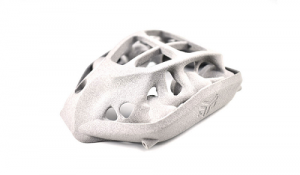 3D printing software and services provider DigiFabster recently released a case study about its customer MakeItQuick, a UK 3D printing service bureau. DigiFabster helps machine shops and service bureaus like MakeItQuick generate more new revenue, while lowering the cost of labor-intensive activities such as order entry, project management, and quoting. MakeItQuick teamed up with DigiFabster not long after it launched, and quickly started seeing results – the company was able to reduce quoting costs by up to 95% and order transaction costs by up to 85%. This allowed MakeItQuick to scale quickly and grow their revenues by 25% a month.
3D printing software and services provider DigiFabster recently released a case study about its customer MakeItQuick, a UK 3D printing service bureau. DigiFabster helps machine shops and service bureaus like MakeItQuick generate more new revenue, while lowering the cost of labor-intensive activities such as order entry, project management, and quoting. MakeItQuick teamed up with DigiFabster not long after it launched, and quickly started seeing results – the company was able to reduce quoting costs by up to 95% and order transaction costs by up to 85%. This allowed MakeItQuick to scale quickly and grow their revenues by 25% a month.
“The software handles 90% of our quotes without the need to manually review every part that is submitted. The time savings were immediately evident,” said Marco Massi, the owner of MakeItQuick.
“We save even more once a quote is confirmed. All the order details are at hand, giving us the opportunity to analyze the data and decide on the best way forward.
“In less than a year with DigiFabster, our revenue has grown steadily. We’re now experiencing a 25% monthly revenue increase, paving the way for our future success.”
IAM 3D HUB’s New Technological Partner
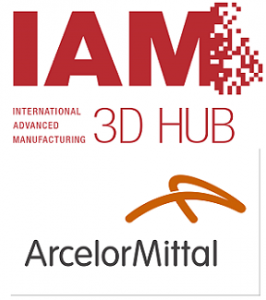 The latest technological partner of AM technology incubator IAM 3D HUB is ArcelorMittal, one of the world’s top steel and mining companies. The company, which has a presence in 60 countries and an industrial footprint in 18, will support the Barcelona-based hub with its technologies, materials, and knowledge to allow for new applications of and metal materials for 3D printing. The two share similar objectives, but ArcelorMittal hopes to use its experiences to contribute a new point of view.
The latest technological partner of AM technology incubator IAM 3D HUB is ArcelorMittal, one of the world’s top steel and mining companies. The company, which has a presence in 60 countries and an industrial footprint in 18, will support the Barcelona-based hub with its technologies, materials, and knowledge to allow for new applications of and metal materials for 3D printing. The two share similar objectives, but ArcelorMittal hopes to use its experiences to contribute a new point of view.
ArcelorMittal’s membership in IAM 3D HUB will allow it to develop new metal 3D printing materials, as well as leverage the hub’s end-to-end solutions platform and work with stakeholders. By incorporating this company, the hub is welcoming a new member in the value chain of 3D printing “as a material developer.” It joins technological developers like HP, Renishaw, and Wacker Chemie, strategic partner Fira de Barcelona, and post-processing specialist Abrast by Coniex.
SmarTech Publishing: New Research Note on Metal Powder Bed Fusion
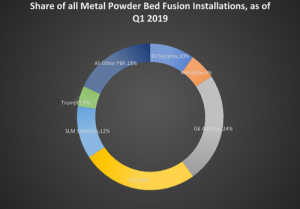 Less than a year ago, 3DPrint.com’s owner, 3DR Holdings, acquired an interest in industry analysis firm SmarTech Markets Publishing, and we continue to have a great relationship. If you’re ever interested in reading the firm’s latest data reports or market studies, you can find them all under the Research tab on our home page. Speaking of research, SmarTech’s VP of Research Scott Dunham, who has prepared the company’s Additive Manufacturing with Metal Powders Report for the last five years, recently released a research note on metal powder bed fusion, titled “Who Will Win (and Who Will Lose) the Metal PBF Marathon?”
Less than a year ago, 3DPrint.com’s owner, 3DR Holdings, acquired an interest in industry analysis firm SmarTech Markets Publishing, and we continue to have a great relationship. If you’re ever interested in reading the firm’s latest data reports or market studies, you can find them all under the Research tab on our home page. Speaking of research, SmarTech’s VP of Research Scott Dunham, who has prepared the company’s Additive Manufacturing with Metal Powders Report for the last five years, recently released a research note on metal powder bed fusion, titled “Who Will Win (and Who Will Lose) the Metal PBF Marathon?”
“Despite what headlines, technologists, and marketing executives would have you believe, the metal 3D printing “race” is a marathon, not a sprint. To continue with the metaphor, we’re probably in about mile 10 of the race today –certainly not at the beginning anymore, but also quite a long way from the end. We are now about twenty three years since the first commercial metal powder bed fusion (PBF) systems came into view,” Dunham wrote.
“With so many closely comparable suppliers of metal PBF equipment now vying for market share, this begs the question, who has what it takes to make it? Everyone in the race today is working toward similar visions of an “Industry 4.0” future that hinges on metalworking going fully digital and highly automated from end to end, from prototyping all the way up to scaled production, with varying levels of customization capabilities based on industry needs along the way.”
Dunham goes on to list some of the technology’s “standout traits,” and names the company’s predictions on how the metal PBF race will turn out: which companies will be the front runners (EOS, GE Additive, Trumpf).
To learn more, check out SmarTech’s recently published “Powder Bed Fusion Markets, A Metal Additive Manufacturing Market Analysis.”
Discuss these stories and other 3D printing topics at 3DPrintBoard.com or share your thoughts below.
The post 3D Printing News Briefs: August 3, 2019 appeared first on 3DPrint.com | The Voice of 3D Printing / Additive Manufacturing.

